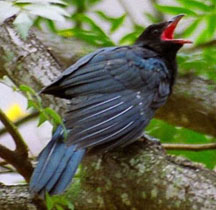Koel.(
Eudynamys scolopacea )
-RagooRao
This month's bird is the Koel. The koels are very active this time of the year as a lot of trees and shrubs will be in fruit. The crows are
also building their nests and the koels are busy looking for one to lay their eggs.
The name Koel is more familiar to Indians than the actual bird. It is always compared to sweet voiced singers.
Koels find mention in a lot old Hindi poetry and Kannada poetry and songs.
It is called Kogilay in Kannada language.
A crow sized glistening black iridescent bird with a shrill
KikoooooK....kikoooook ...kikook call repeated several times in trees betrays the presence the bird. They are found in rural as well as urban areas on tall treetops feeding on berries and fruits. In fact it is one of the major seed dispersal agent
for a lot of species of trees and shrubs. The females are very different in coloration with brown body parts and heavily barred and spotted in white. Their red glistening eyes are unique. The beak is greenish yellow. They are found singly or in pairs during
the mating season.
The koel is distributed through the country. Their flight is straight and fast. When one male is calling other males join in from different
trees until there is a full chorus of cuckoo calls. The earliest bird heard in the morning is the koel.
Nesting season is similar to the house and jungle crows because the koel always lay their eggs in a crows nest for the stupid crow- with
all its fame as being the most intelligent bird, plays foster parent to the young. The female koel is even observed to push out the host's eggs and lay her eggs. Eggs are similar to that of the crow, pale greyish green with speckles, but a little smaller.

The female koel lays large number of eggs in different crows nests to make sure. Different females also lay eggs in the same crows nest and
this may be the reason to believe that the koel herself lays a lot of eggs. This fact has to be scientifically either confirmed or disproved.
Koel is a much mentioned bird in songs and considered the heralder of spring and plenty. Let us Admire and Protect this bird both for poetry's
sake and more importantly for their role in seed distributing of various trees and shrubs.